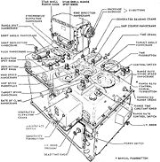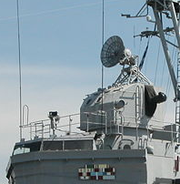
Mark I Fire Control Computer
Encyclopedia


United States Navy
The United States Navy is the naval warfare service branch of the United States Armed Forces and one of the seven uniformed services of the United States. The U.S. Navy is the largest in the world; its battle fleet tonnage is greater than that of the next 13 largest navies combined. The U.S...
during World War II
World War II
World War II, or the Second World War , was a global conflict lasting from 1939 to 1945, involving most of the world's nations—including all of the great powers—eventually forming two opposing military alliances: the Allies and the Axis...
and up to 1969. It was used on a variety of ships, ranging from destroyer
Destroyer
In naval terminology, a destroyer is a fast and maneuverable yet long-endurance warship intended to escort larger vessels in a fleet, convoy or battle group and defend them against smaller, powerful, short-range attackers. Destroyers, originally called torpedo-boat destroyers in 1892, evolved from...
s (one per ship) to battleship
Battleship
A battleship is a large armored warship with a main battery consisting of heavy caliber guns. Battleships were larger, better armed and armored than cruisers and destroyers. As the largest armed ships in a fleet, battleships were used to attain command of the sea and represented the apex of a...
s (four per ship). The Mark 37 system used tachymetric
Tachymetric
A tachymetric anti-aircraft fire control system refers to a method of generating target position, speed, direction, and rate of target range change, by computing these parameters directly from measured data....
target motion prediction to compute a fire control solution. Weighing more than 3000 pounds (1363 kilograms), the Mark 1 itself was installed in the plotting room, a water tight compartment that was located deep inside the ship's hull to provide as much protection against battle damage as was possible.
Essentially an electromechanical analog computer
Analog computer
An analog computer is a form of computer that uses the continuously-changeable aspects of physical phenomena such as electrical, mechanical, or hydraulic quantities to model the problem being solved...
, the Mark 1 was electrically linked to the gun turret
Gun turret
A gun turret is a weapon mount that protects the crew or mechanism of a projectile-firing weapon and at the same time lets the weapon be aimed and fired in many directions.The turret is also a rotating weapon platform...
s and the Mark 37 gun director
Director (military)
A director, also called an auxiliary predictor, is a mechanical or electronic computer that continuously calculates trigonometric firing solutions for use against a moving target, and transmits targeting data to direct the weapon firing crew....
, the latter mounted as high on the superstructure as possible to afford maximum visual and radar range. The gun director was equipped with both optical and radar range finding, and was able to rotate on a small barbette
Barbette
A barbette is a protective circular armour feature around a cannon or heavy artillery gun. The name comes from the French phrase en barbette referring to the practice of firing a field gun over a parapet rather than through an opening . The former gives better angles of fire but less protection...
-like structure. Using the range finders, the director was able to produce a continuously varying set of outputs, referred to as line-of-sight (LOS) data, that were electrically relayed to the Mark 1 via synchro motors
Synchro
A synchro is a type of rotary electrical transformer that is used for measuring the angle of a rotating machine such as an antenna platform. In its general physical construction, it is much like an electric motor...
. The LOS data provided the target's present range, bearing, and in the case of aerial targets, altitude. Additional inputs to the Mark 1 were continuously generated from the stable vertical, a gyroscopic device that reacted to the roll and pitch of the ship, the pitometer log
Pitometer log
Pitometer logs are devices used to measure a ship's speed relative to the water. They are used on both surface ships and submarines...
, which measured the ship's speed through the water, and an anemometer
Anemometer
An anemometer is a device for measuring wind speed, and is a common weather station instrument. The term is derived from the Greek word anemos, meaning wind, and is used to describe any airspeed measurement instrument used in meteorology or aerodynamics...
, which provided wind speed and direction.
In "Plot" (the plotting room), a team of sailor
Sailor
A sailor, mariner, or seaman is a person who navigates water-borne vessels or assists in their operation, maintenance, or service. The term can apply to professional mariners, military personnel, and recreational sailors as well as a plethora of other uses...
s stood around the 4 feet (1.2 m) Mark 1 and continuously monitored its operation. They would also be responsible for calculating and entering the average muzzle velocity
Muzzle velocity
Muzzle velocity is the speed a projectile has at the moment it leaves the muzzle of the gun. Muzzle velocities range from approximately to in black powder muskets , to more than in modern rifles with high-performance cartridges such as the .220 Swift and .204 Ruger, all the way to for tank guns...
of the projectile
Projectile
A projectile is any object projected into space by the exertion of a force. Although a thrown baseball is technically a projectile too, the term more commonly refers to a weapon....
s to be fired before action started. This calculation was based on the type of propellant
Propellant
A propellant is a material that produces pressurized gas that:* can be directed through a nozzle, thereby producing thrust ;...
to be used and its temperature, the projectile type and weight, and the number of rounds fired through the guns to date.
Given these inputs, the Mark 1 automatically computed the lead angles to the future position of the target at the end of the projectile's time of flight, adding in corrections for gravity, relative wind, the magnus effect
Magnus effect
The Magnus effect is the phenomenon whereby a spinning object flying in a fluid creates a whirlpool of fluid around itself, and experiences a force perpendicular to the line of motion...
of the spinning projectile, and parallax
Parallax
Parallax is a displacement or difference in the apparent position of an object viewed along two different lines of sight, and is measured by the angle or semi-angle of inclination between those two lines. The term is derived from the Greek παράλλαξις , meaning "alteration"...
, the latter compensation necessary because the guns themselves were widely displaced along the length of the ship. Lead angles and corrections were added to the LOS data to generate the line-of-fire (LOF) data. The LOF data, bearing and elevation, as well as the projectile's fuze time, was sent to the turrets by synchro motors, whose motion actuated hydraulic machinery to aim the guns.
Once the system was "locked" on the target, it produced a continuous fire control solution. While these fire control systems greatly improved the long-range accuracy of ship-to-ship and ship-to-shore gunfire, especially on heavy cruiser
Heavy cruiser
The heavy cruiser was a type of cruiser, a naval warship designed for long range, high speed and an armament of naval guns roughly 203mm calibre . The heavy cruiser can be seen as a lineage of ship design from 1915 until 1945, although the term 'heavy cruiser' only came into formal use in 1930...
s and battleships, it was in the anti-aircraft warfare
Anti-aircraft warfare
NATO defines air defence as "all measures designed to nullify or reduce the effectiveness of hostile air action." They include ground and air based weapon systems, associated sensor systems, command and control arrangements and passive measures. It may be to protect naval, ground and air forces...
mode that the Mark 1 made the greatest contribution. However, the anti-aircraft value of analog computers such as the Mark 1 was greatly reduced with the introduction of jet aircraft
Jet aircraft
A jet aircraft is an aircraft propelled by jet engines. Jet aircraft generally fly much faster than propeller-powered aircraft and at higher altitudes – as high as . At these altitudes, jet engines achieve maximum efficiency over long distances. The engines in propeller-powered aircraft...
, where the relative motion of the target became such that the computer's mechanism could not react quickly enough to produce accurate results.
The design of the post war Mark 1A may have been influenced by the Bell Labs Mark 8, Fire Control Computer
Mark 8, Fire Control Computer
The Mark 8 Fire Control Computer was developed by Bell Laboratories during World War II. It was initially requested by the USN Bureau of Ordnance as an alternative to the Ford Instruments Mark I Fire Control Computer, in case supplies of the Mk I were interrupted or were unable to be manufactured...
which was developed as an all electrical computer, incorporating technology from the M9 gun data computer
Gun Data Computer
The gun data computer is a series of artillery computers used by the U.S. Army, for coastal artillery, field artillery, and antiaircraft artillery applications...
as a safeguard to ensure adequate supplies of fire control computers for the USN during WW2. Surviving Mark 1 computers were upgraded to the Mark 1A standard after World war Two ended.
Digital fire control computers were not introduced until the age of minicomputers in the mid-1970s.
See also
- Ship gun fire-control system
- Admiralty Fire Control TableAdmiralty Fire Control Tablethumb|Admiralty Fire Control Table in the transmitting station of [[HMS Belfast |HMS Belfast]].The Admiralty Fire Control Table was an electromechanical analogue computer fire-control system that calculated the correct elevation and deflection of a Royal Navy cruiser or battleships' main armament,...
- High Angle Control System
- Gun data computerGun Data ComputerThe gun data computer is a series of artillery computers used by the U.S. Army, for coastal artillery, field artillery, and antiaircraft artillery applications...

